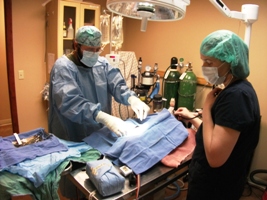Spaying Pot-belly Pigs
Female pot-bellied pigs are known as gilts if they've never been pregnant, and sows if they have produced at least one litter. Gilts are usually spayed at a young age to prevent undesirable traits such as odor, aggressiveness, mounting of other pets and people, and urine-marking. Spaying prevents diseases such as uterine tumors which are common in older intact gilts and sows. We recommend that a spay is performed when a gilt is between 4 and 6 months of age. If an intact gilt is already showing these behaviors, she may never lose these traits even once she has been spayed.
We pre-treat young pigs with a tranquilizer so that they are calm and can be easily handled throughout their time at the hospital. We recommend pre-surgical bloodwork to ensure that your pig is healthy enough for full anesthesia and the surgery, and we also recommend placing an intravenous catheter so that your pig maintains proper blood pressure and hydration throughout the procedure. Once we are sure your pig is healthy enough for the next step, it will receive some pain-relieving medications, and then will inhale an anesthetic gas through a face mask which causes it to fall asleep. We then place an endotracheal tube to ensure that it cannot inhale saliva, and to ensure that its airway is open so that it will continue to breathe the anesthetic gas and oxygen at safe levels. There are two gas anesthetics we use, sevoflurane and isoflurane. Isoflurane is safe for most pigs, but some are higher risk and sevoflurane is a better choice.

A young pig that has been intubated and placed on a ventilator delivering anesthetic gas and oxygen.
Your pig will be prepared for surgery. A technician will shaved the area of the incision, and will scrub and disinfect the site so it is sterile for the surgery. The veterinarian will scrub in and gown to maintain sterile technique. The technician will monitor heart rate and breathing throughout the procedure, and alert the veterinarian if there are any changes in the patient's status.

Dr. Johnson preparing to perform surgery on a young pig (in this case, a neuter). Melissa is monitoring the pig's vital signs.
Following the surgery, your pig will be placed in a dark quiet area for recovery. Once it is able to stand without wobbling, it will be monitored for another hour or so to ensure it is ready to go home. Your pig will receive pain-relieving medications to be given at home. It's important to keep your pig away from dirt, and to minimize its running and jumping for at least 7 days following surgery. If you notice redness, swelling, oozing, opening of the wound, or an unpleasant smell, an immediate recheck is needed. Your doctor may have other specific recommendations, so please follow those instructions.
This pot-bellied piglet was spayed by the breeder's veterinarian, and arrived with sutures that needed to be removed. If you notice redness, swelling, oozing, opening of the incision, or an unpleasant odor, please get your piglet seen by a veterinarian immediately!



